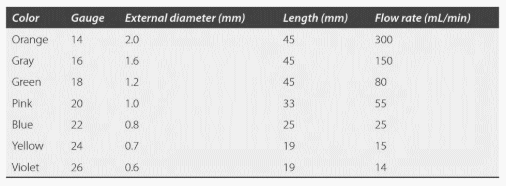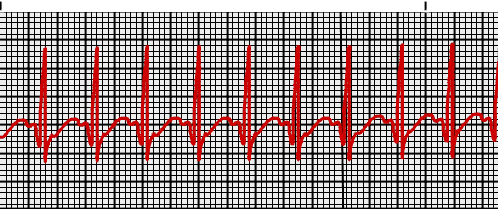Present day IV cannulae are available from sizes 14 gauge to 26 gauge with universal color coding for easy recongnition of IV cannula. Smaller the gauge, wider is the cannula and has higher flow rate.
- Normal adult size: 18-20 G
- Situations requiring rapid fluid transfusion like trauma: 14-16 G
- Preferred pediatric size: 22 G
- Infants and neonates: 24-26 G
Here is an image mnemonic and will require your imagination. Imagine the environment around you.
- The earth has magma inside (orange color) – 14 G
- There is soil on surface (grey color) – 16 G
- Grass has grown on the soil (green color) – 18 G
- Pink flower has grown above the grass (pink color) – 20 G
- Above is the blue sky (blue color) – 22 G
- The sun is in the sky (yellow color) – 24 G


Or simply remember this mnemonic: Oh Great God, please bless your progeny (OGGPBYV)
- Orange
- Grey
- Green
- Pink
- Blue
- Yellow
- Purple/Violet
Another easy way to do is to use the rhyme:
a. Blue: Twenty two (22 G)
b. Green: Eighteen (18 G)
External diameter of cannula:
Remember the pink (20 G) cannula is 1 mm in diameter. For cannula next to pink: 1 +/- 0.2 mm
- 18 G (green): 1.2 mm
- 22 G (blue): 0.8 mm
For cannula smaller “gauze” than 18 G:
- 16 G (grey): 1.2 + 0.4 = 1.6 mm
- 14 G (orange):1.6 + 0.4 = 2 mm
For cannula larger than 22 G:
- 24 G (yellow): 0.8 – 0.1 = 0.7 mm
- 26 G (purple): 0.7 – 0.1 = 0.6 mm
Or, simply remember that the diameter of pink cannula is 1 mm, that of purple is almost half, i.e. 0.5 mm and that of orange is almost double, i.e. 2 mm and others are in between these.



Think there might be some typo in the text. Picture (https://epomedicine.com/wp-content/uploads/2020/04/iv-cannula.gif) with below text are mismatch.
External diameter of cannula:
Remember the pink (20 G) cannula is 1 mm in diameter. For cannula next to pink: 1 +/- 0.2 mm
18 G (green): 0.8 mm –> this green one should be 1.2mm as per in the picture.
22 G (blue): 1.2 mm –> this blue one should be 0.8mm as per in the picture.
For cannula smaller than 18 G:
16 G (grey): 0.8 – 0.1 = 0.7 mm –> this grey one should be 1.6mm as per in the picture.
14 G (orange): 0.7 – 0.1 = 0.6 mm –> this orange one should be 2.0mm as per in the picture.
For cannula larger than 22 G:
24 G (yellow): 1.2 + 0.4 = 1.6 mm –> this yellow one should be 0.7mm as per in the picture.
26 G (purple): 1.6 + 0.4 = 2 mm –> this purple one should be 0.6mm as per in the picture.
Please re-edit this content and make sure accurate double/triple-check information before publish. Thank you.
Thank you for the correction. We have updated the article with correction.
Thanks, it is very insightful.
Thanks…………. We want to more information….